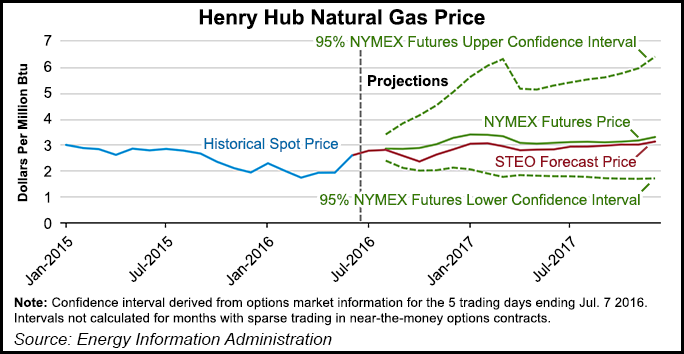NGI The Weekly Gas Market Report | Markets | NGI All News Access
EIA Bumps 2016 NatGas Price Forecast Higher: $2.36/MMBtu
Henry Hub natural gas spot prices reached a nine-month high in June, according to the Energy Information Administration (EIA), which bumped its forecast for 2016 prices up to $2.36/MMBtu, with 2017 prices expected to average $2.95/MMBtu.

“Henry Hub spot prices rose in June and averaged $2.59/MMBtu for the month, the highest monthly average since September 2015,” EIA said in its latest Short-Term Energy Outlook (STEO). “The increase in prices comes as production has declined and as demand for natural gas to fuel electricity generation has increased.” While natural gas prices are expected to gradually rise in the short term, they are likely to remain lower than they were last summer, EIA said.
Last month, EIA said it expected 2016 Henry Hub prices to average $2.22/MMBtu and 2017 prices to average $2.96/MMBtu (see Daily GPI, June 7). While EIA’s 2016 price forecast was increased for the second time this year (see Daily GPI, May 10), it remains well below the agency’s February forecast of $2.64/MMBtu (see Daily GPI, Feb. 9). EIA’s price forecasts declined steadily throughout 2015 (see Daily GPI, Dec. 8, 2015; Jan. 13, 2015) before firming a bit in January (see Daily GPI, Jan. 25).
Henry Hub prices averaged $2.59/MMBtu last month, an increase of 67 cents from May, according to the STEO. Natural gas futures prices for October 2016 delivery (for the five-day period ending July 7) averaged $2.88/MMBtu.
Current options and futures prices imply that market participants place the lower and upper bounds for the 95% confidence interval for October 2016 contracts at $2.00/MMBtu and $4.14/MMBtu, respectively. At this time last year, the natural gas futures contract for October 2015 averaged $2.85/MMBtu and the corresponding lower and upper limits of the 95% confidence interval were $1.92/MMBtu and $4.24/MMBtu, EIA said.
Holding a lid on prices are bulging natural gas inventories, which ended March at 2,494 Bcf, the highest end-of-withdrawal season level on record. “During May and June, injections have been somewhat lower than the previous five-year (2011-15) average,” EIA said. Last week, EIA reported a 39 Bcf injection for the week ending July 1, bringing natural gas inventories to 3,179 Bcf (see Daily GPI, July 7).
“Even with lower-than-average storage injections, EIA forecasts natural gas inventories to be 4,022 Bcf at the end of October 2016, which would be the highest level on record for that time of year,” the agency said.
Natural gas production last month average 79.1 Bcf/d, down almost 1.0 Bcf/d from a record-high daily average set in February (see Daily GPI, June 1), but EIA expects production to rise through 2016 and 2017 in response to forecast price increases and increases in liquefied natural gas (LNG) exports. EIA said it expects production to rise by 1.0% in 2016 and by 2.4% in 2017.
Natural gas exports by pipeline to Mexico have been on the rise this year, and EIA expects that growth to continue because of growing demand from Mexico’s electric power sector and flat natural gas production in Mexico. Gross pipeline exports are expected to increase by 0.7 Bcf/d this year, before falling by 0.2 Bcf/d next year to an average of 5.3 Bcf/d.
EIA projects LNG gross exports will increase to an average of 0.5 Bcf/d in 2016, with the startup of Cheniere’s Sabine Pass LNG liquefaction plant in Louisiana, which sent out its first cargo in February (see Daily GPI, Feb. 24). EIA projects gross LNG exports will average 1.3 Bcf/d in 2017 as Sabine Pass ramps up its capacity.
“With expected growth in gross exports, net imports of natural gas shrink from 2.6 Bcf/d in 2015 to 0.2 Bcf/d in 2017, and the United States is expected to become a net exporter of natural gas during the second half of 2017,” EIA said (see Daily GPI,July 1).
Total natural gas consumption is expected to average 76.5 Bcf/d this year and 77.7 Bcf/d next year, compared with 75.3 Bcf/d in 2015. Gas consumption is expected to increase in the electric power sector by 4.9% this year before declining 1.4% in 2017 as natural gas prices rise and contribute to increasing coal generation. Forecast industrial sector consumption of natural gas increases by 2.7% in 2016 and by 1.5% in 2017 as new fertilizer and chemical projects come online.
© 2024 Natural Gas Intelligence. All rights reserved.
ISSN © 1532-1231 | ISSN © 2577-9877 | ISSN © 1532-1266 |
